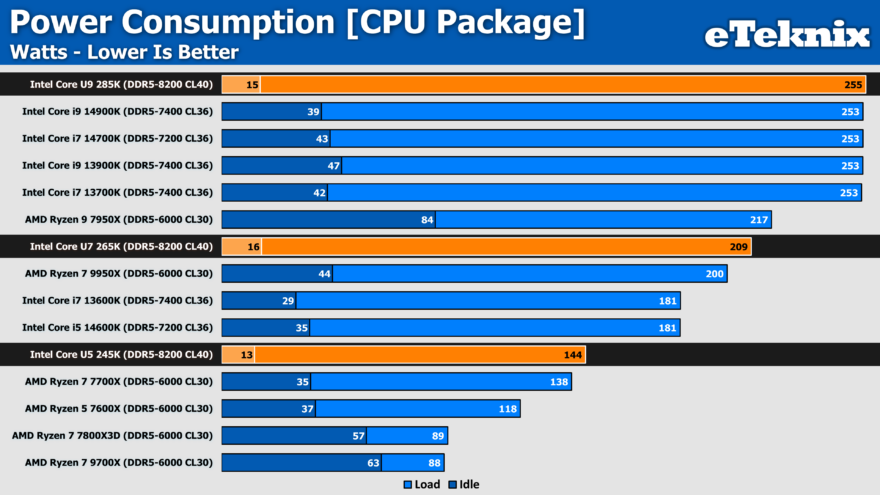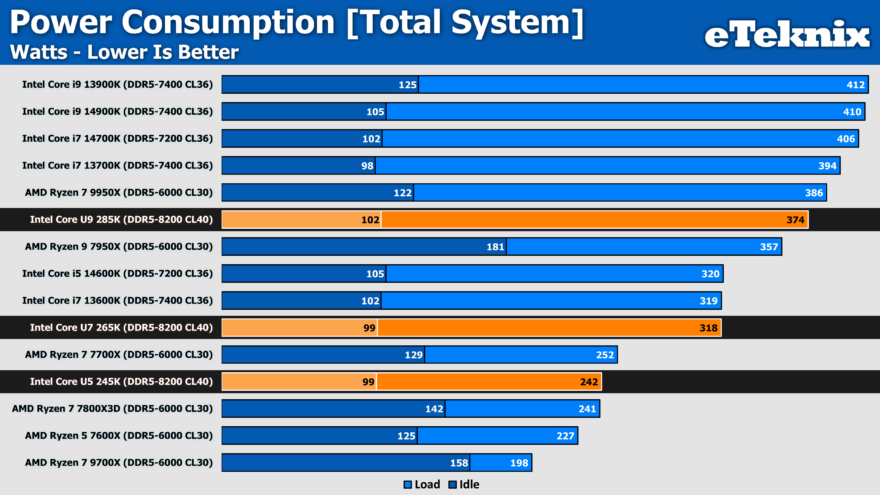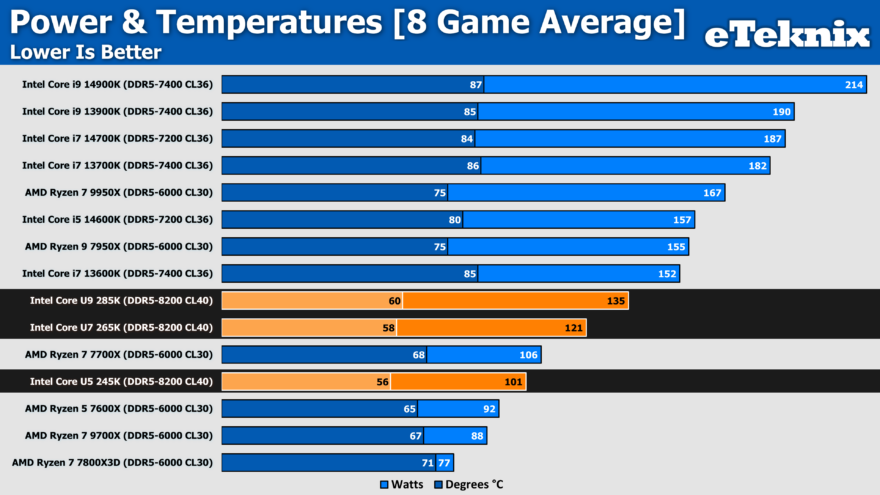Intel Core Ultra 7 265K CPU Review
Power & Temperatures

Now I said at the start that these CPUs are all about power and efficiency and that’s very much the case, because Intel have seemingly listened to the complaints set out by consumers when it came to the 14th gen, and mainly on the higher-end i9 parts. That’s why we measured power consumption at idle and during Cinebench, and also during gaming. It’s here where at idle, the new Core Ultra CPUs really excel due to their efficiency cores and how the architecture is working. We typically see figures around the 15 watts mark while sitting on the desktop, which is a significant improvement over the 14th generation and now also comes in much lower than anything AMD have to offer. During load, the U9 tops our chart, matching the power limit levels of the 14900K, 14700K, 13900K and 13700K but that’s expected anyway, while the U7 comes in just between the 7950X and 9950X and the U5 comes in closer matched to that of the 7700X.

The total system power shows a slightly different story with the U9 coming in closer to its predecessor at idle, but nestled between the 9950X and 7950X during load, so a bit of a win there for Intel. The U7 and U5 match each other at idle, but are quite different at load with the U7 matching power with the 13600K and 14600K, so quite an achievement considering the extra performance, while the U5 is closer to that of the 7800X3D and below the 7700X, though the 9700X is still looking impressive here.

In gaming and looking at the power and temperatures over an 8-game average, we find some significant improvements. Starting with the U9 which actually ended up using on average 79 watts less power than the i9 14900K, while the U7 came in using 61 Watts less on average compared to the 14700K, and then the U5 came in using 56 Watts less than the 14600K. This also puts all 3 of the new CPUs in a much better place compared to AMD’s 9950X, 7950X and you could argue, 7700X.
In terms of temperatures, this is another area where things get pretty cool if you excuse the pun. The U9 285K now comes in 27 degrees lower than its predecessor, while the U7 265K comes in 26 degrees lower than the 14700K, and the U5 245K comes in 24 degrees lower, and this also means that all 3 of these CPUs come in cooler than anything AMD have to offer which while it doesn’t necessarily offer huge amounts of extra performance, it’s a great selling point for consumers.

Now the real reason you’re likely here is gaming, so let’s put the big focus on that, because that really comes down to a few things including game engines, utilisation, and how the game interacts with what instructions are on offer, and I think it’s clear to see that there is potentially performance left on the table that could be found through refinement by the game developers, mainly when you look at titles like Cyberpunk. Other games like Riftbreaker, well I think that’s a different story, because of the type of title it is, and how it interacts, I think the loss of hyperthreading and speed has taken a hit there.
As always, to get a better idea as to what’s going on, it’s worth taking a look at the overall average FPS. It’s here where we find, well. Not much. The U5 245K comes in at 174 FPS on average across all ten games, compared to 172 FPS on the 14600K, which equates to just 1%, so retesting could see this come in even closer, so for the sake of being fair, we’ll call it identical. For the U7 265K, that too came in 2 FPS higher than its previous generation counterpart so again, 1% so neither here nor there. Then for the U9 285K we see no change when comparing to the 14900K as it comes in identically at 187 frames per second.
When factoring in the cost of the CPUs, this results in a cost per frame of $1.78 for the U5 245K, $2.18 for the U7 265K and $3.14 for the U9 285K which are all higher than the 14th generation, but as always, this is based on the cost of these CPUs now, which are inflated somewhat due to them being new, compared to the 14th gen for instance, which has seen prices tumble since their launch. How this now compares to AMD is comparatively close to the likes of the 9950X, again being a new product when putting it against the U9, while the U7 is closer to the 7800X3D, though that comes in much higher in the average FPS. Then the U5 is comparable to the 9700X which offers up slightly more performance, but comes in slightly higher in overall cost.








